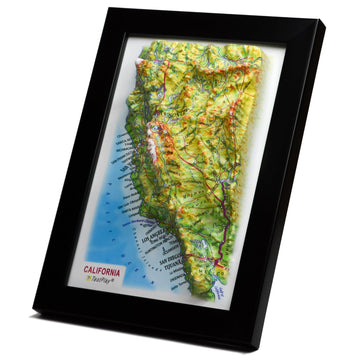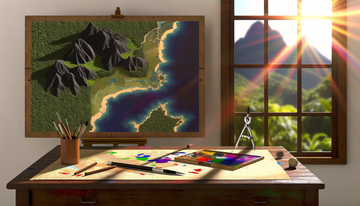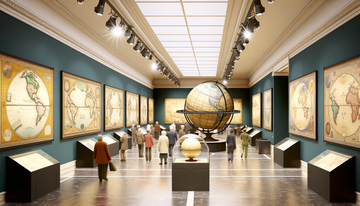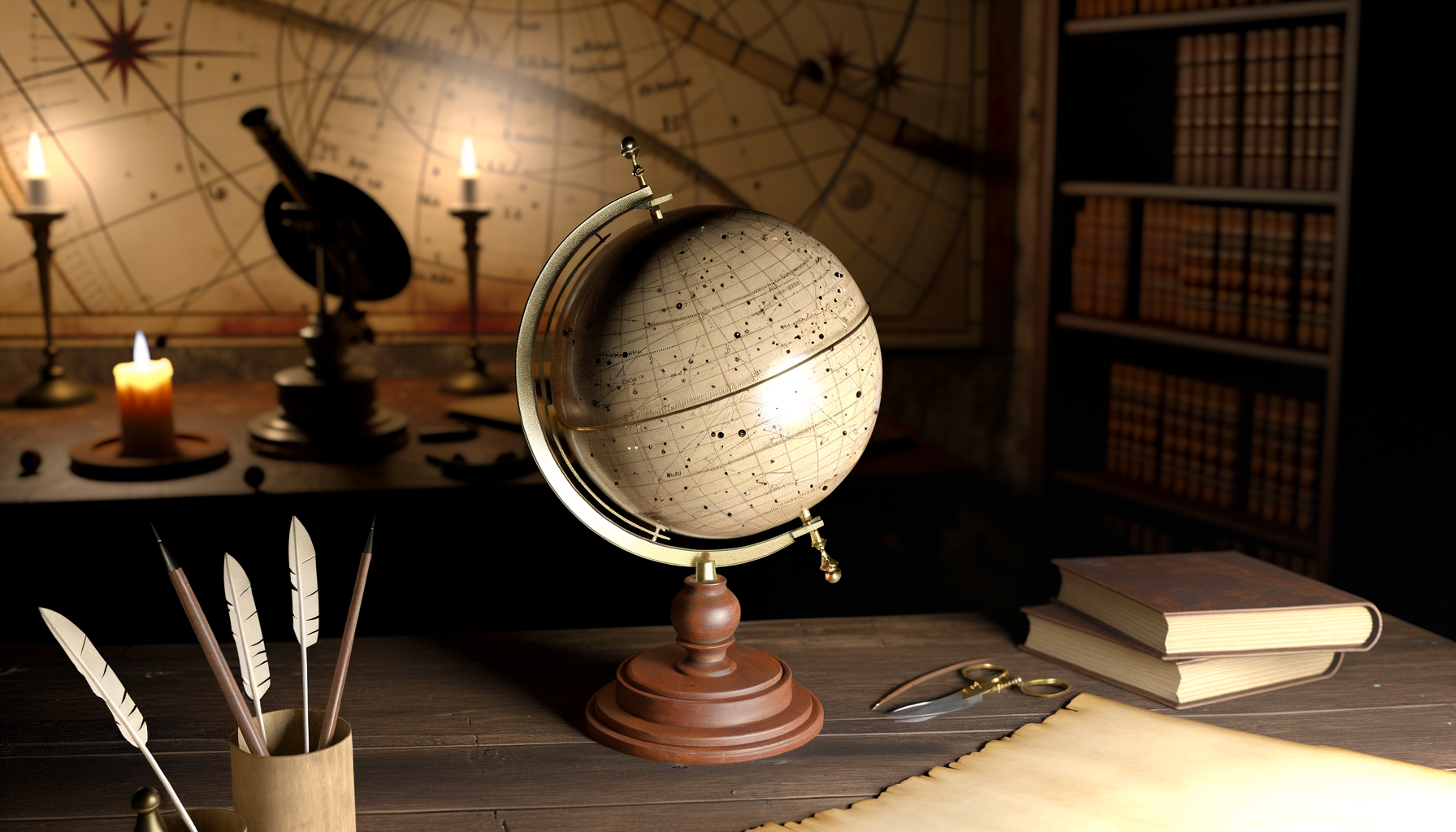Unlock the Night Sky: An Authoritative Guide to Celestial Globes and Star Mapping
Introduction: Charting the Cosmos Through Time
The night sky has captivated humanity for millennia, a vast and mysterious canvas prompting questions about our place in the universe.For centuries, before the advent of sophisticated telescopes and digital star charts, one of the most elegant and effective tools for visualizing and understanding the celestial sphere was the celestial globe.
These beautiful artifacts served not only as scientific instruments but also as stunning works of art, bridging the gap between complex astronomical concepts and tangible representation.
Many people today are fascinated by antique celestial globes, curious about how they work, and eager to understand the rich history they represent.
This comprehensive guide will take you on a journey through the world of celestial globes, defining what they are, exploring their fascinating history, detailing their key components, explaining how they were used to map and navigate the stars, and discussing their enduring relevance today.
Whether you are an astronomy enthusiast, a history buff, an art lover, or a collector, this post offers the insights needed to appreciate these magnificent models of the cosmos and perhaps even inspires you to look at the night sky with a new perspective.
What Exactly is a Celestial Globe? Visualizing the Heavenly Sphere
At its core, a celestial globe is a three-dimensional model of the celestial sphere.Unlike a terrestrial globe, which maps the surface of the Earth, a celestial globe maps the apparent positions of stars, constellations, and other astronomical objects as seen from Earth.
The concept of the celestial sphere is central to understanding these globes; it is an imaginary sphere of immense radius concentric with Earth, upon which all celestial bodies appear to be projected.
While we know the stars are at vastly different distances, they *appear* to us as if fixed on this distant sphere, making the globe a highly effective representation of this apparent geometry.
By depicting the stars and constellations on a physical sphere, a celestial globe provides an intuitive way to visualize the relationships between celestial objects and understand their positions in the sky relative to one another and to the observer on Earth.
These globes are typically viewed *from the outside*, representing the view of the sky surrounding our planet, placing the observer conceptually at the center of this grand celestial sphere, though the stars themselves are depicted on the outer surface.
A Journey Through Time: The Rich History of Celestial Globes
The desire to map the stars is as old as civilization itself, and the concept of representing the cosmos three-dimensionally has ancient roots.Celestial globes have a history stretching back over two millennia, evolving in design, accuracy, and purpose alongside humanity's understanding of the universe.
Ancient Roots and Early Concepts
The earliest known celestial globe dates back to antiquity, with evidence suggesting their use in ancient Greece.One of the most famous early depictions is the Farnese Atlas, a Roman copy of a Greek sculpture from the Hellenistic period (circa 2nd century BC), which shows the titan Atlas holding a celestial globe on his shoulders.
This globe depicts constellations known to ancient Greek astronomers, demonstrating that the idea of a spherical representation of the heavens was established early on.
Ptolemy, the influential Greco-Roman astronomer, described the celestial sphere and cataloged stars in his Almagest (2nd century AD), providing a theoretical foundation and practical data that would inform globe making for centuries.
During the Golden Age of Islam, scholars preserved and advanced astronomical knowledge, producing detailed star catalogs and potentially creating globes, although surviving examples from this very early period are rare.
These early globes were likely highly prized objects, serving astronomical, educational, and even astrological purposes.
The Golden Age of Globe Making (Renaissance to the 19th Century)
The art and science of celestial globe making flourished during the Renaissance and continued through the Age of Exploration and the Enlightenment.Advances in printing, engraving, and cartography, combined with renewed interest in classical learning and the discovery of new stars and constellations visible from the Southern Hemisphere, fueled a surge in globe production.
European globe makers, including renowned figures in the Netherlands, Italy, England, and France, created increasingly detailed and accurate globes.
These globes often featured beautifully engraved copper plates, which were then printed onto gores (shaped segments) and meticulously pasted onto a spherical core.
The constellations were frequently depicted not just as points of light but with elaborate and artistic figures representing the mythological or animal forms associated with them.
Globes from this era varied in size, from small, portable versions to large, impressive library globes, often paired with a matching terrestrial globe.
They were essential tools for teaching astronomy, demonstrating celestial mechanics, and providing a visual reference for star gazers and scholars.
Major scientific discoveries, such as the heliocentric model proposed by Copernicus, gradually influenced astronomical thought, but celestial globes continued to depict the sky from a geocentric perspective, as this is how the stars *appear* from Earth, regardless of the true arrangement of the solar system.
This pragmatic approach ensured their continued utility as observational aids and teaching tools.
Decline and Enduring Appeal
By the late 19th and early 20th centuries, celestial atlases and planispheres became more common and arguably more practical for many astronomical purposes.The advent of photography and new methods of printing further changed how celestial information was disseminated.
Consequently, large-scale production of traditional celestial globes began to decline, and their role shifted from primary scientific instrument to educational aid, decorative object, and collectible.
However, interest in these historical artifacts has remained strong.
Antique celestial globes are highly sought after by collectors, appreciated for their craftsmanship, historical significance, and artistic beauty.
Modern reproductions and smaller globes are still produced today, serving educational purposes and allowing new generations to experience the tangible connection to the cosmos that these objects provide.
Studying the history of celestial globes offers a unique window into the evolution of astronomy, art, and technology over centuries.
Anatomy of the Celestial Sphere: Understanding the Key Components
A celestial globe is more than just a sphere with stars on it; it is a complex instrument designed to replicate the movements and structure of the apparent sky.Understanding its various components is key to appreciating its function and historical context.
The Globe Itself: A World of Stars
The central element is the sphere, typically made from materials like paper maché over wood or metal, or sometimes directly from copper.The surface is meticulously prepared to receive the printed or engraved gores, which are segments carefully shaped to fit onto the sphere without distortion.<
Once the gores are applied, seams are often hidden, and the surface is colored and varnished.
The constellations are depicted on this surface, often with detailed artistic renderings of the figures they represent, based on classical traditions and later astronomical observations.
Individual stars are plotted, with their apparent brightness (magnitude) sometimes indicated by the size or style of the symbol used.
Important celestial lines and features are also engraved or printed onto the globe's surface.
Mapping the Cosmos: Essential Celestial Markings
Several critical lines and circles are depicted on the globe to help locate objects and understand celestial mechanics.The **Celestial Equator** is the projection of Earth's equator onto the celestial sphere.
It is a fundamental reference line for the celestial coordinate system analogous to latitude on Earth.
The **Ecliptic** is the apparent path of the Sun across the celestial sphere over the course of a year.
It is tilted with respect to the celestial equator at an angle of approximately 23.5 degrees, reflecting the tilt of Earth's rotational axis.
The points where the ecliptic and celestial equator intersect are the **Vernal Equinox** (the First Point of Aries) and the **Autumnal Equinox**; these are important reference points.
**Hour Circles** and **Declination Circles** form a coordinate grid on the globe, similar to longitude and latitude on Earth.
Hour circles converge at the celestial poles, while declination circles are parallel to the celestial equator.
These allow astronomers to pinpoint the location of any celestial object using coordinates known as Right Ascension (measured along the celestial equator or by hour circles from the vernal equinox) and Declination (measured north or south from the celestial equator).
The Supporting Structure: Mountings and Rings
Celestial globes are mounted on a stand that often incorporates several movable rings and components, essential for orienting the globe and making measurements.The globe is typically attached to an **Axis** passing through its celestial poles, allowing it to rotate.
This rotation simulates the apparent daily motion of the stars caused by Earth's rotation.
The **Meridian Ring** is a full brass circle that the globe's axis passes through.
It is usually graduated in degrees (0 to 90-0-90), allowing the user to measure the Declination of objects (their angular distance north or south of the celestial equator).
It is also often marked with hours, corresponding to the hour circles on the globe, facilitating measurements of Right Ascension or sidereal time.
The **Horizon Ring** is a horizontal circle surrounding the globe at its equator or base.
It represents the observer's local horizon and is usually marked with degrees (0 to 360) representing azimuth.
Crucially, the horizon ring often incorporates scales for the **Zodiac** (the band of constellations through which the Sun, Moon, and planets appear to move) and a **Calendar** scale.
These scales allow the user to set the globe to represent the sky at a specific date and time.
The entire assembly is supported by an ornate **Stand** or base, which can range from simple wooden designs to elaborate carved or metal structures.
Some mounts allow the meridian ring to swivel within the stand, enabling the globe to be tilted to match the observer's latitude on Earth, accurately representing the visible sky from that location.
How to Navigate the Stars: Using a Celestial Globe
While not as commonly used for modern navigation or professional astronomy, understanding how to use a celestial globe provides fascinating insight into historical astronomical practices and offers a unique perspective on the night sky.Using a traditional globe involves a few key steps to align it with the current or a historical view of the heavens.<
Setting Up for Your Location and Time
To use a celestial globe accurately, you first need to orient it to your specific location and the desired time.If the globe's mounting allows, you would tilt the meridian ring within the stand so that the celestial pole is elevated above the horizon ring by an angle equal to your latitude.
For example, if you are at 40 degrees North latitude, you would tilt the axis so the North Celestial Pole is 40 degrees above the horizon ring.
Next, you use the calendar and zodiac scales on the horizon ring in conjunction with the hour circles or meridian ring to set the globe for a specific date and time.
Aligning the Sun's position on the ecliptic for the given date with the correct sidereal time (which accounts for Earth's rotation relative to the stars) on the hour circle scale will orient the globe to show the stars visible at that moment from your set latitude.
This process requires a bit of understanding of astronomical timekeeping, but essentially, you are rotating the globe on its axis and tilting the assembly to match the actual orientation of the sky.
Finding Celestial Objects and Understanding Motion
Once set, the globe becomes a miniature working model of the visible sky.You can easily locate constellations and bright stars plotted on the globe's surface.
Using the hour circles and declination circles, you can find objects based on their celestial coordinates (Right Ascension and Declination).
The horizon ring clearly indicates which parts of the celestial sphere are currently above the horizon and thus potentially visible from your location.
Objects near the center of the globe visible above the horizon ring will be high in the sky, while those near the edge of the visible portion will be low.
By rotating the globe on its axis, you can simulate the apparent daily motion of the stars as they rise in the east and set in the west, just as they appear to do in the real sky.
This rotation also demonstrates which stars are circumpolar (always above the horizon for your latitude) and which are never visible.
Moving the indicator on the horizon ring through the calendar year while keeping the time setting constant illustrates how the visible constellations change seasonally as Earth orbits the Sun.
This tangible interaction makes understanding these fundamental astronomical concepts much more intuitive than studying flat maps.
Why Celestial Globes Still Matter Today
In an age of digital star charts and powerful telescopes controlled by computers, one might wonder about the relevance of celestial globes.Yet, these historical instruments retain significant value and appeal for multiple reasons.
Bridging History and Science
Celestial globes serve as tangible links to the history of astronomy and cartography.They show us how astronomers centuries ago visualized and recorded the cosmos, reflecting the scientific knowledge and artistic styles of their time.
Examining an antique globe allows us to see the constellations as depicted by past cultures and appreciate the laborious process of astronomical observation, calculation, engraving, and printing involved in their creation.
They embody the intellectual progress of humanity's quest to understand the universe, from ancient myths projected onto the stars to the inclusion of newly discovered celestial features.
They are artifacts that tell a story of human curiosity and ingenuity across generations.
Educational and Inspirational Tools
For students and enthusiasts, celestial globes offer a uniquely intuitive way to grasp the concept of the celestial sphere and celestial coordinates.Unlike flat star maps, which can distort perspectives, a globe accurately represents the angular relationships between objects in the sky.
Manipulating a globe allows for a hands-on understanding of celestial motion, the impact of latitude on the visible sky, and the meaning of concepts like the celestial equator and ecliptic.
Holding and using a globe can inspire a deeper appreciation for the night sky and the history of astronomy, making abstract concepts more concrete and engaging.
They are particularly effective in educational settings for demonstrating foundational principles.
Artistic and Collectible Value
Beyond their scientific and historical importance, celestial globes are often stunning works of art.The craftsmanship involved in creating the sphere, engraving the plates, and constructing the ornate stands is often exquisite.
The detailed and sometimes imaginative depictions of constellations add significant artistic appeal.
Antique globes are highly prized by collectors for their rarity, condition, provenance, and the reputation of the globe maker.
They represent a significant investment in historical artifacts and decorative arts.
Even modern reproductions or simplified globes can be beautiful and inspiring objects to display and use.
Conclusion: Cosmic Models Endure
Celestial globes, these magnificent spheres depicting the starry heavens, are far more than mere historical curiosities.They are powerful representations of humanity's age-old quest to map, understand, and connect with the cosmos.
From their ancient origins as philosophical and astronomical models to their peak as indispensable tools for education and visualization, they have played a vital role in our journey of cosmic discovery.
By exploring their history, deciphering their components, and learning how they were used, we gain a deeper appreciation for the ingenuity of past astronomers and the enduring nature of the celestial sphere concept.
Whether encountered in museums, studied in collections, or used as educational aids, celestial globes continue to inspire wonder and provide a unique, tangible link to the vastness of the universe above us.
They remind us that the stars we see today are the same stars that captivated observers centuries ago, and that the tools we create to understand them are reflections of our persistent curiosity and creativity.
Next time you gaze up at the night sky, perhaps you will visualize it as a grand celestial globe surrounding you, a cosmic map waiting to be explored, just as our ancestors did with the beautiful and intricate globes they created.




